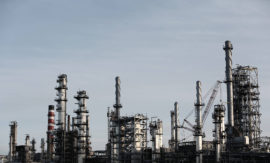Intended learning outcomes: Differentiate between primary product, by-product, and waste product. Explain the manufacture of by-products in chemical production.
One of the characterizing features of the processor-oriented concept is divergent product structure. This type of structure is an upside-down arborescent structurewith by-products.
A primary product is the product that the production process is designed to manufacture.
A by-product is a material of value produced as a residual of or incidental to the process producing the primary product. A waste product is seen as a by-product without any value.
Manufacture of by-products is the simultaneous creation — that is, in the same manufacturing step — of further products in addition to the primary product.
The process often starts with a single commodity (raw material or intermediate product), although sometimes several commodities are processed together. The resulting products can be either intermediate products or end products. In some cases, a number of by-products (frequently steam or power) arise in addition to the primary product(s). By-products do not go directly into other products, but they can be recovered, utilized, and recycled in subsequent production processes. In contrast to by-products, which can reenter into the production process either directly or after appropriate treatments, waste products must be disposed of. Waste treatment and disposal engender additional costs.
The first example in Figure 8.1.1.1 stems from the chemical process industry.
Fig. 8.1.1.1 Chemical production process: reactor with distillation column.
Here, the production of by-products is the result of physical and chemical reactions, or occurs through the changeable operating states of the production equipment. The processor can produce three grades (A, B, and C) of a certain fluid product. Basic material G moves from a feed tank (buffer) to the reactor. The chemical reaction produces the desired material, but also by-product N, which is separated out through the aid of a distillation column, by supplying heat and generating vapor. N exits the distillation column and the production unit.
A change of product from one grade to another without shutting down the reactor involves resetting temperature and pressure. Transitional materials are obtained as a result of these changes. These materials are of a lesser quality, and later they will have to be mixed with a sufficient quantity of high-grade materials, which will be produced once operations reach a stable state. This means that a large quantity of each grade must be produced before the next change of product. Figure 8.1.1.2 shows the flow of goods using MEDILS notation (see Section 4.1.2).
Fig. 8.1.1.2 The manufacture of by-products in chemical production.
Continuation in next subsection (8.1.1b).
Example for manufacture of by-products: Mineral oil
The preparation of mineral oil is a typical example of manufacture of by-products: a minimum of two products are produced at the same time in one step of a production process. The following Flash animation illustrates how a multitude of products are manufactured from a single base material (raw oil) in a production process that has many steps. The presentation clearly shows that manufacture of by-products is typically connected with divergent product structures. This is even more impressive considering that most refinery products are themselves raw materials for entire industries (e.g., plastics).
Course section 8.1: Subsections and their intended learning outcomes

8.1 Characteristics of the Process Industry
Intended learning outcomes: Explain divergent product structures and by-products. Describe high-volume line production, flow resources and inflexible facilities. Produce an overview on large batches, lot traceability, and loops in the order structure.

8.1.1 Divergent Product Structures, Primary Products, By-Products, and Waste Products
Intended learning outcomes: Differentiate between primary product, by-product, and waste product. Explain the manufacture of by-products in chemical production.

8.1.1b Manufacture of By-Products in Mechanical Production: Sheet Metal Working
Intended learning outcomes: Describe the manufacture of by-products in sheet metal working.

8.1.1c Manufacture of By-Products in Mechanical Production: Collets from a Steel Cylinder and Temporary Assembly
Intended learning outcomes: Disclose the production of collets from a steel cylinder as well as the “saucepan and lid” problem linked with temporary assembly.

8.1.2 High-Volume Line Production, Flow Resources, and Inflexible Facilities
Intended learning outcomes: Describe flow resources within a process stage. Explain the need for flexible capability (of the production equipment) in chemical production.

8.1.3 Large Batch Size, Lot Traceability, and Loops in the Order Structure
Intended learning outcomes: Explain the need for lot traceability. Present reasons for loops in the product structure.
